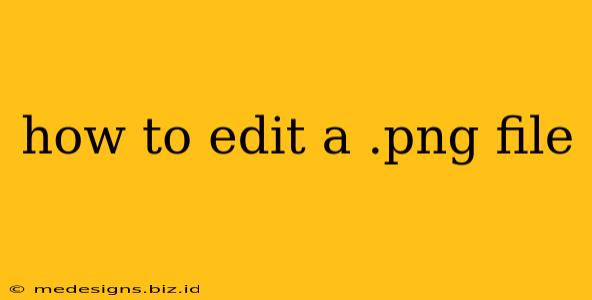.PNG files, known for their lossless compression and support for transparency, are ubiquitous in graphic design and web development. But what happens when you need to tweak a .PNG? This guide explores various methods for editing .PNG files, catering to different skill levels and needs.
Understanding .PNG Files
Before diving into editing, understanding the .PNG format's strengths is crucial. .PNG (Portable Network Graphics) is a raster image format, meaning it's composed of pixels. Unlike JPEG, .PNG uses lossless compression, preserving image quality even after multiple edits. Its key advantage is transparency support, allowing you to use images with transparent backgrounds seamlessly in various applications.
Choosing the Right Tool: Software Options for Editing .PNGs
The best tool for editing your .PNG depends on your experience and the complexity of your edits. Here's a breakdown of popular options:
1. Adobe Photoshop: The Industry Standard
For professional-grade editing, Adobe Photoshop reigns supreme. Its extensive features allow for intricate manipulations, including:
- Precise color correction: Adjust individual colors, saturation, and brightness with pixel-perfect accuracy.
- Advanced layer management: Work with multiple layers to edit specific elements without affecting others.
- Powerful retouching tools: Remove blemishes, sharpen images, and perform complex manipulations.
- Filter effects: Apply numerous filters to enhance or alter the image's appearance.
However, Photoshop requires a subscription and has a steeper learning curve.
2. GIMP (GNU Image Manipulation Program): The Free and Open-Source Alternative
GIMP offers a powerful, free, and open-source alternative to Photoshop. While it lacks some of Photoshop's advanced features, it provides a comprehensive set of tools for editing .PNG files, including:
- Basic and advanced editing tools: Similar to Photoshop, GIMP allows for color correction, layer management, and retouching.
- Customizable interface: Tailor the workspace to your preferences.
- Extensive plugin support: Expand functionality with community-created plugins.
GIMP has a slightly less intuitive interface than Photoshop, but numerous online tutorials are available to help you get started.
3. Online PNG Editors: Quick and Easy Solutions
For simple edits, numerous online PNG editors offer convenient, browser-based solutions. These tools often provide features like:
- Cropping: Easily trim unwanted portions of the image.
- Resizing: Adjust the dimensions of the image.
- Basic color adjustments: Modify brightness, contrast, and saturation.
- Adding text: Insert text directly onto the image.
While convenient, online editors typically lack the advanced features of desktop applications.
4. Paint.NET: A Free and User-Friendly Option
Paint.NET is a free and user-friendly image editor ideal for beginners. It provides a good balance between simplicity and functionality, including:
- Layers: Allows for non-destructive editing.
- Effects: Offers a variety of effects to enhance your images.
- Intuitive interface: Easy to learn and use.
Common .PNG Editing Tasks and Techniques
Here are some common tasks when editing .PNG files:
1. Resizing a .PNG
Maintaining aspect ratio is crucial when resizing. Most image editors offer options to constrain proportions, preventing distortion.
2. Removing the Background from a .PNG
The magic wand tool in many image editors helps select areas of similar color, making background removal easier. More advanced techniques involve using layers and masks for precise selection.
3. Adding Text to a .PNG
Use the text tool to add text. Choose appropriate fonts, sizes, and colors to maintain visual harmony.
4. Applying Filters and Effects
Experiment with different filters and effects to enhance your image. Filters can add creative touches or correct imperfections.
Best Practices for Editing .PNG Files
- Save frequently: Prevent losing your work due to unexpected crashes.
- Work with copies: Always work on a copy of the original file to avoid damaging the original.
- Optimize for web: When preparing .PNGs for the web, consider compressing them to reduce file size without significant quality loss.
By understanding the different tools and techniques, you can confidently edit your .PNG files, achieving professional-looking results, regardless of your skill level. Remember to choose the tool that best suits your needs and always back up your original files before making any changes.
